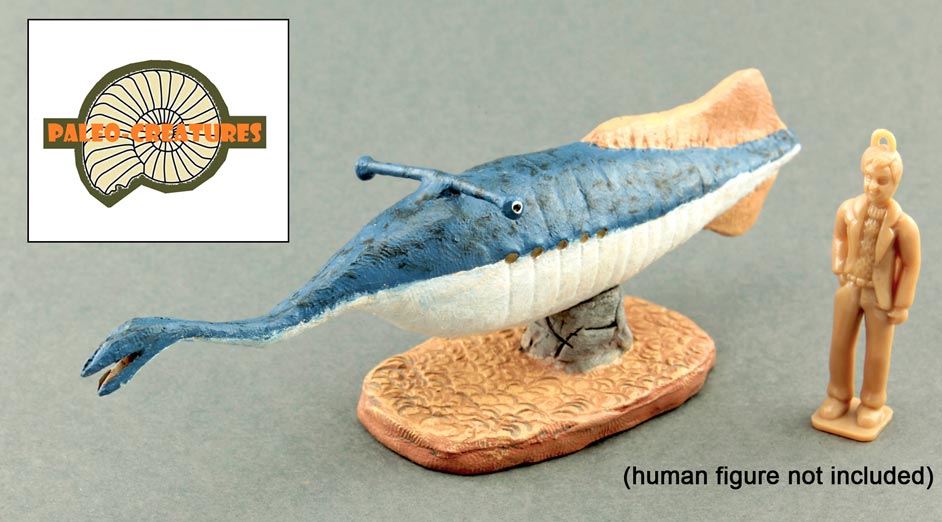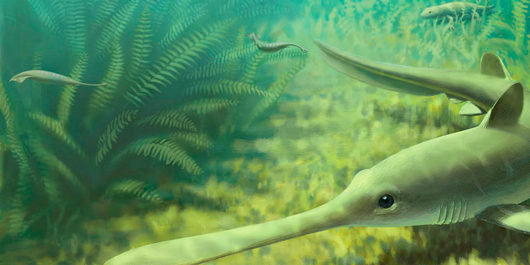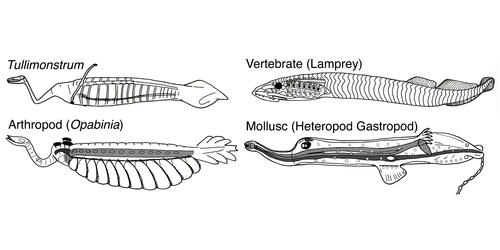The Tully Monster Just Lost its Backbone
“Tully Monster” Mystery Not Solved
Back in March 2016, Everything Dinosaur published an article on the enigmatic “Tully Monster” (Tullimonstrum gregarium), a bizarre creature of coastal waters and estuaries, first described in 1966, but not classified until fifty years later. Trouble is, the proposal that this thirty-centimetre-long, stalk-eyed animal was a vertebrate has been challenged.
Tullimonstrum gregarium
It seems that the mystery surrounding how to classify the State fossil of Illinois (fossils have only been found in the Mazon Creek area of Illinois and nowhere else in the world), has not been solved.
The Bizarre Carboniferous Marine Animal Tullimonstrum gregarium
Picture credit: Everything Dinosaur/Paleo-Creatures
The Taxonomic Classification of the “Tully Monster”
Two separate recent studies had proposed that the “Tully Monster” was a soft-bodied vertebrate, one that is related to extant jawless fishes such as the very slimy Hagfish and the Lamprey (a fish, perhaps most famous for causing the demise of Henry I, the son of William the Conqueror, who died from a “surfeit of lampreys”.)
To read an article supporting the T. gregarium was a vertebrate theory: Tully Monster Riddle Solved.
Vertebrate Theory Challenged
Palaeobiologists at the University of Pennsylvania have challenged the idea that Tullimonstrum was a primitive fish with a proboscis. Writing in the academic journal “Palaeontology”, lead author Assistant Professor Lauren Sallan, (Dept. of Earth and Environmental Science) and her co-workers refute the vertebrate hypothesis.
Lauren stated:
”This animal doesn’t fit easily in classification because it’s so weird. It has these eyes that are on stalks and it has this pincer at the end of a long proboscis and there’s even disagreement about which way is up. But the last thing that the Tully monster could be is a fish.”
Sallan and colleagues, which include Robert Sansom (University of Manchester), postdoctoral researcher John Clarke, Zerina Johnason (Natural History Museum, London), Sam Giles (Oxford University), Ivan Sansom of the University of Birmingham and Philippe Janvier of France’s Muséum National d’Histoire Naturelle, postulate that that the two papers which seemingly settled the “Tully Monster” debate are flawed, failing to definitively classify it as a vertebrate.
Considering Enigmatic Fossils
Junior Research Fellow Giles explained:
“It’s important to incorporate all lines of evidence when considering enigmatic fossils: anatomical, preservational and comparative. Applying that standard to the Tully Monster argues strongly against a vertebrate identity.”
The Ancient Waters of the Mazon Creek Area 300 Million Years Ago
Picture credit: John Megahan
“Tully Monster” Riddle
The “Tully Monster” has been known since the 1950s, when the first fossils were found in the Mazon Creek fossil beds in central Illinois. Since then, thousands of specimens have been identified from this locality, but they are not found anywhere else in the world.
Looking at the history of classification, Sallan explained that at first it was thought to be some sort of marine worm, then it was proposed that it was a form of mollusc, like a sea-slug. Other palaeontologists have argued that this strange little animal has affinities with the Arthropoda, perhaps a distant relative of today’s shrimp. Then in 2016, two research papers were published proposing that T. gregarium was actually a member of the back-boned group of animals – a vertebrate.
For models and replicas of prehistoric animals: Prehistoric Animal Models, Replicas and Figures.
Evidence for the Vertebrate Theory
One study examined more than 1,200 Tullimonstrum fossils. In some, the researchers observed a light band running down the creature’s mid-line, which they interpreted as a notochord, a kind of primitive backbone. They also said it contained other internal organ structures, such as gill sacs, that identified it as a vertebrate, and that the animal’s teeth resembled those of a lamprey.
Assistant Professor Sallan and her colleagues noted that these conclusions are based on a misunderstanding of how fossils in Mazon Creek are preserved. The “Tully Monster” samples come from what was once a muddy estuarine area and at Mazon Creek, internal soft tissues are very rarely preserved. Lamprey fossils have been found in the Mazon Creek area and these fossils are markedly different from their supposed relative the Tullimonstrum.
Studying the Eyes
In the other 2016 study, the researchers reported that scanning electron microscope images of the eyes had revealed structures called melanosomes, which produce and store melanin. That paper’s authors argued that the complex tissue structure they saw in the animals’ eyes indicated it was likely a vertebrate. The Pennsylvania University led team counter this point by arguing that many arthropods and molluscs, also have complex eyes.
Sallan added:
“Eyes have evolved dozens of times. It’s not too much of a leap to imagine Tully Monsters could have evolved an eye that resembled a vertebrate eye.”
Based on Sallan and her colleagues’ examination of Tullimonstrum eyes, these creatures in fact possess what is known as a cup eye, a relatively simpler structure that lacks a lens.
“So the problem is, if it does have cup eyes, then it can’t be a vertebrate because all vertebrates either have more complex eyes than that or they secondarily lost them. But lots of other things have cup eyes, like primitive chordates, molluscs and certain types of worms,” the Assistant Professor stated.
More Than a Thousand Specimens Studied
In this research, not one of more than a thousand fossil specimens studied appeared to possess structures that are believed to be universal in aquatic vertebrates, namely otic capsules, components of the ear that allow animals to balance and a lateral line, a sensory structure along the flanks that enables fishes to orient themselves and to detect their surroundings.
Comparing the Anatomy of Tullimonstrum to Other Creatures
Picture credit: Pennsylvania University
Lauren went onto state:
“You would expect at least a handful of the specimens to have preserved these structures. Not only does this creature have things that should not be preserved in vertebrates, it doesn’t have things that absolutely should be preserved.”
The researchers said that an improper classification of such an unusual species has ripple effects on the larger field of evolution.
“Having this kind of misassignment really affects our understanding of vertebrate evolution and vertebrate diversity at this given time. It makes it harder to get at how things are changing in response to an ecosystem if you have this outlier. And though of course there are outliers in the fossil record, there are plenty of weird things and that’s great, if you’re going to make extraordinary claims, you need extraordinary evidence.”
It looks like, for the time being at least the “Tully Monster” has lost its backbone.
Visit the Everything Dinosaur website: Everything Dinosaur.




